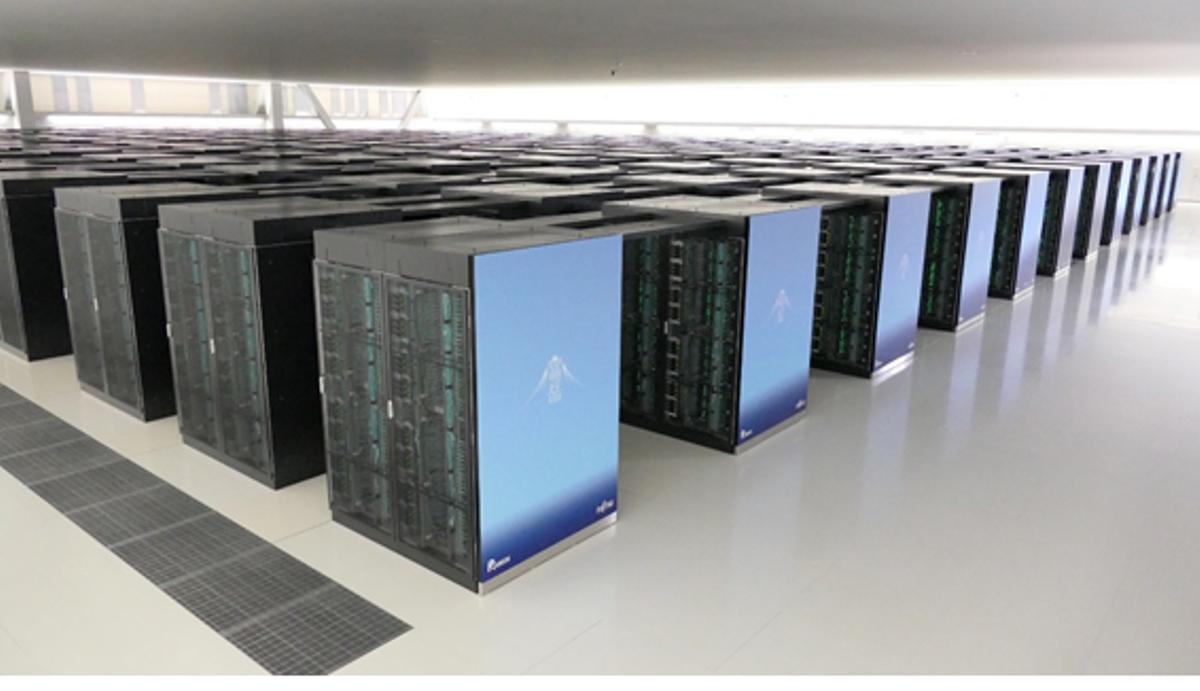After seven years in the works, the world’s fastest supercomputer has officially been completed in Japan and is now available for researchers to start using, for projects ranging from fighting climate change to discovering new drugs.
Builds for the Fugaku supercomputer, hosted at Japanese scientific research institute Riken, started in 2014 in collaboration with Fujitsu, with the device pitched to become a future pillar of the country’s high-performance computing infrastructure.
The delivery of Fugaku’s total 432 racks was completed in May 2020; since then, trials of the system have been on-going, mainly with projects aiming to accelerate research to combat the COVID-19 pandemic. The computer is now fully open for shared use, and Japan’s Research Organization for Information Science and Technology (RIST) has already selected 74 research projects that will be implemented from next month.
RIST has also urged researchers to submit proposals for new projects, and invited all applications to be sent in as part of a call for Trial Access Projects.
Together with Riken, Fujitsu will continue to monitor the operation of Fugaku to ensure stable performance, while also working to enhance the user environment, and to provide better supercomputing technologies.
“The ultra-high-performance computer Fugaku is about to go into full-scale operation,” said RIST president Yasuhide Tajima. “I look forward to seeing this most powerful ‘external brain’ ever developed by humanity helping to expand our knowledge, enabling us to gain deeper insights into the foundation of matter in both time and space, giving us better structural and functional analysis of life, society, and industry, enabling more accurate predictions; and even designing the unknown future of humanity.”

Since last year, trials of the system have been on-going, mainly with projects aiming to accelerate research to combat the Covid-19 pandemic.
Image: Riken/ FujitsuFugaku is designed to carry out high-resolution, long-duration, and large-scale simulations, and boasts up to 100 times the application performance of its predecessor, the K supercomputer, which was decommissioned in 2019.
This unprecedented compute power has earned the device the top spot for two consecutive terms in the Top500 list, which classifies the 500 most powerful computer systems around the world. At 442 petaflops, Fugaku stands a long way ahead of competitors, with three times more capability than the number two system on the list, IBM’s Summit, which has a performance of 148.8 petaflops.
Paired with AI and data science, these simulations are expected to provide high-level results to solve problems at a new scale. Among the many anticipated outcomes feature high-speed and high-precision drug discovery simulations, early detection of diseases, accurate predictions and simulation of natural disasters, creation of new materials for next-generation batteries or fuel cells, and even increased insights into fundamental science questions such as the creation of the universe.
Results from the trials carried out with the supercomputer are already promising. Researchers in Japan have been using Fugaku to test the efficiency of existing drugs against Covid-19, as well as to find ways to mitigate Covid-19 transmission through detailed droplet analysis.
In a separate project, Japan’s Tokyo Medical and Dental University (TMDU) and Fujitsu Laboratories revealed that the supercomputer had enabled them to achieve cancer gene analysis in less than a day, instead of months. By allowing for a better understanding of the relationship between cancer cells and cancer-related genes, the study could help establish new cancer therapies.
“This is just the beginning for Fugaku, and we are looking forward to seeing it truly demonstrate its tremendous potential,” said Riken president Hiroshi Matsumoto. “Above all, Fugaku is a key national technology, and we will manage it responsibly with the goal to achieve research results that will help build a long-lived and healthy society, disaster mitigation, and better energy use, with the ultimate goal to establish the government’s vision of an ultra-smart Society 5.0.”
Alongside Fugaku, Japan holds another 33 supercomputers in the latest Top500 list; and although the country has firmly settled in the top space, other nations are ramping up their efforts to develop ever-more powerful devices. The US, for example, is currently building two exascale computing systems expected to launch next year. China and the EU have also both announced projects to develop exaflop-capable supercomputers in the next few years.






















